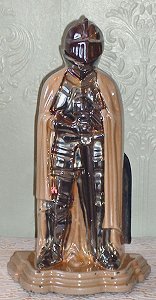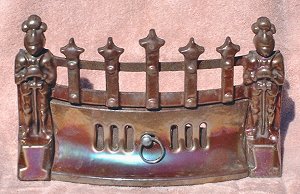 |
THE QUEST FOR
|
 |
| As a result of Jim's publicity several people got in touch. Mrs. M. King had a grate, which had originally belonged to her parents. It is clearly the Bilston Knight grate shown in the advert. She very kindly donated the whole fitting to the BCMC. Mrs. King knew her grate as a Bilston Knight and reported it to Jim as such, even though the news story had referred only to companion sets. There is only one colour of enamel on it, suggesting that it is either the armorial or the lustre finish and that these colours were alternatives.. |  |
Mrs. Christine While has two knights, which she has had for at least 30 years. These are about the same height as the other knights but quite different in design - they are, for example, the only ones with the visor raised so that a face - including moustache - can be seen. The dark blue/black enamel is like that seen on other items but the red knight is a much more vivid colour than seen elsewhere. These knights, like all the other items, have no maker's mark on them. |  |
  |
Mrs. Christine Radford has a knight, in two colours of enamel, which had been enamelled by her father. Christine's father was Clarence Cook. He worked for many years at Jordan's. He bought home two of these knights, one for his wife and the other for his daughter. Christine suggests that she would not have been given a knight had she still been living at home and it is therefore likely that it was given to her after she married in 1960. Her father died in 1965. This means that the knights were still being produced in the early 60s. Christine also thinks that the knights she and her mother had come without the tools. This may have been because her father was only concerned with the enamelling or because the tools were never at Jordan's; but she also thinks it may have been that they were sold like that and you added your own tool set from Woolworths. Certainly, sets seen in antiques markets and elsewhere seem often to have a similar set of bronzed tools in them. But one of Frank's knights has a silvery finish to both the interior of the knight and to the tools, and it all seems to be original. Perhaps you could buy them with or without tools. Christine also said that when such items as oven trays were enamelled they had to be coated and fired twice, once for each side. It seems that it was her father who originally suggested drilling one or two holes in the piece, from which it could be suspended, enabling it to be coated on both sides at once and fired only once. This system was adopted - and the holes can be seen on these later pieces. |
| John Bucknall told us that his father, Tommy Bucknall, had made castings
for the knight sometime in the 1950s when he worked at Fryer's,
Willenhall. Fryer's was mainly a brass foundry which also cast iron.
John had followed his father as a foundryman and had worked at many
foundries, both ferrous and non-ferrous, around the area. He reminded us
that Willenhall was not just locks - that, for example, there were three
brass foundries in Wood Street alone and many other foundries elsewhere.
John said that when casting in sand there is always a tendency for small
quantities of sand to drop into the mould, usually, it seems, in the
most difficult place to get at to remove it. He remembers his father
saying that, when he was dealing with the knights, sand would often fall
into the toe and was extracted only with difficulty. John said that
other foundries made similar items and he thinks that it was Shaw's of
Willenhall who made the companion set in the form of a sailing ship. Mrs. Nancy Potts also has a knight companion set which came from her aunt. Her knight (Right)is in an overall grey finish but with hints of a reddish colour showing through. Mrs. Greenfield also has a companion set which we have not seen. |
 | At roughly this point Frank acquired another knight
(Right) from the
Antiques Centre in Warstones Road. It has a particularly rich dark brown
lustre enamel on it. It has been cast in two parts - the base being a
separate part from the knight himself.
Upon comparing it in detail with his other two knights it becomes clear that all three differ from each other in details of the design, for example, in whether or not the visor has bars to it, the height of the base and so on. |  |
We got in touch with John D. Harper, who was the last Managing Director of John Harper and Co of Willenhall, asking him if he had any recollection of his company doing this work. He wrote: "I have seen the knight companion sets but, so far as I know, these were not made by John Harper and Co". But, he points out, it was not impossible for them to have done so. He added: "I wonder if it was a product of William Harper & Co., a grey iron and malleable foundry that was in Birmingham Street, Willenhall? They were still in business in the 1950s".
 |
Barbara Garratt has a knight which she remembers buying, through a mail order catalogue, when she got married in 1965. But this knight is not the same pattern as most of the others. It is different in all details, most obviously in that he has a shield. The enamel on him is a particularly dark brown lustre, appearing almost black in some lights. |  |
Mrs. Lilley had a fire grate, which she very
kindly donated to the BCMC. It has a front of a portcullis type and
sides which consist of knights. The enamelling appears not to be of the best, the portcullis across the front is somewhat thin and the two knights are not very realistically modelled. It may have been produced as a cheaper alternative to the Bilston Knight, either by Bilston Foundry or by some rival company; or it may simply have been a non-continuous burning type. |
click here to go on to page 3 of the Bilston knights click here to return to the Industry front page